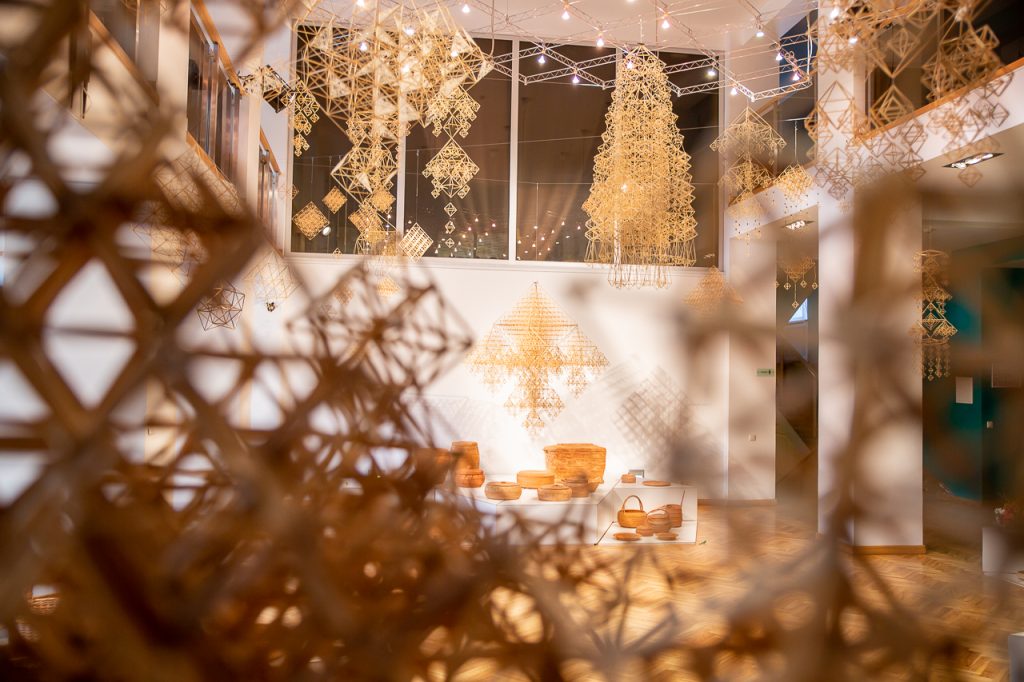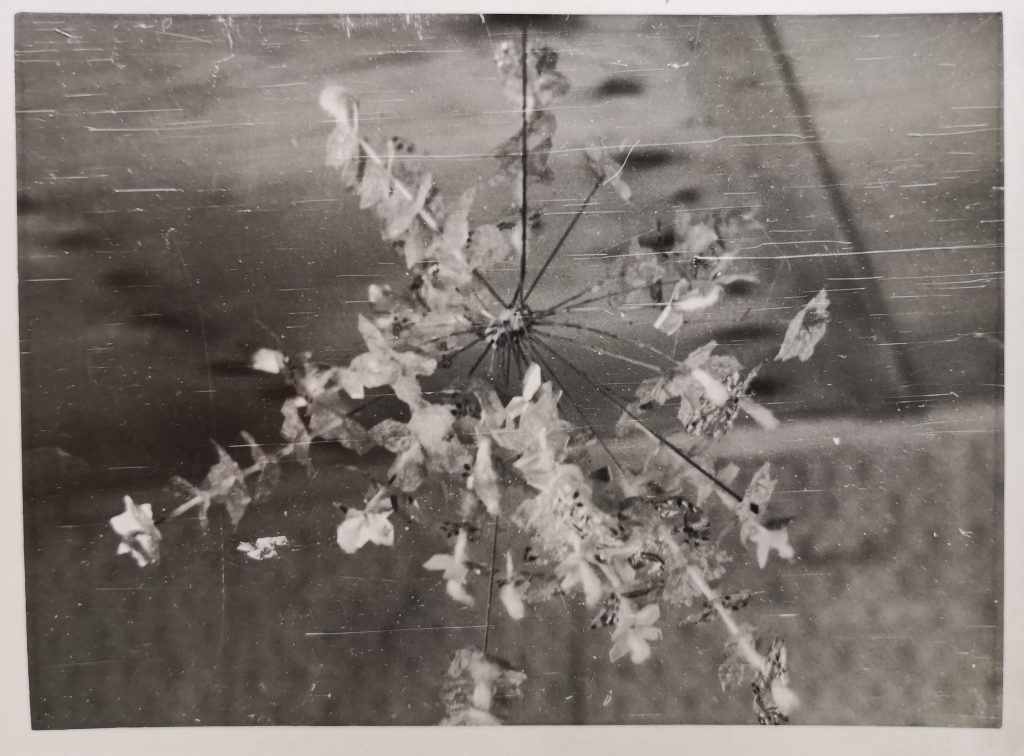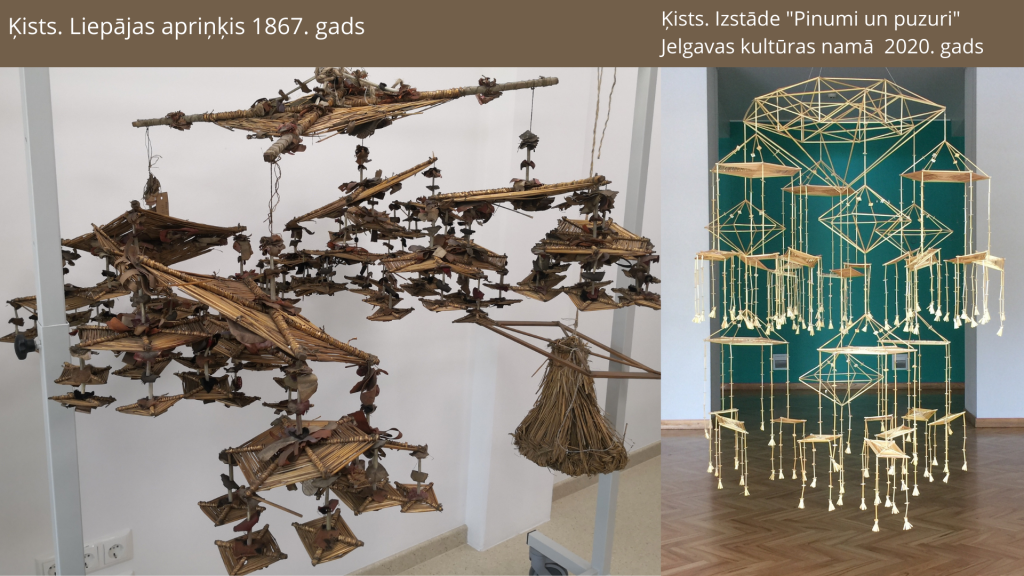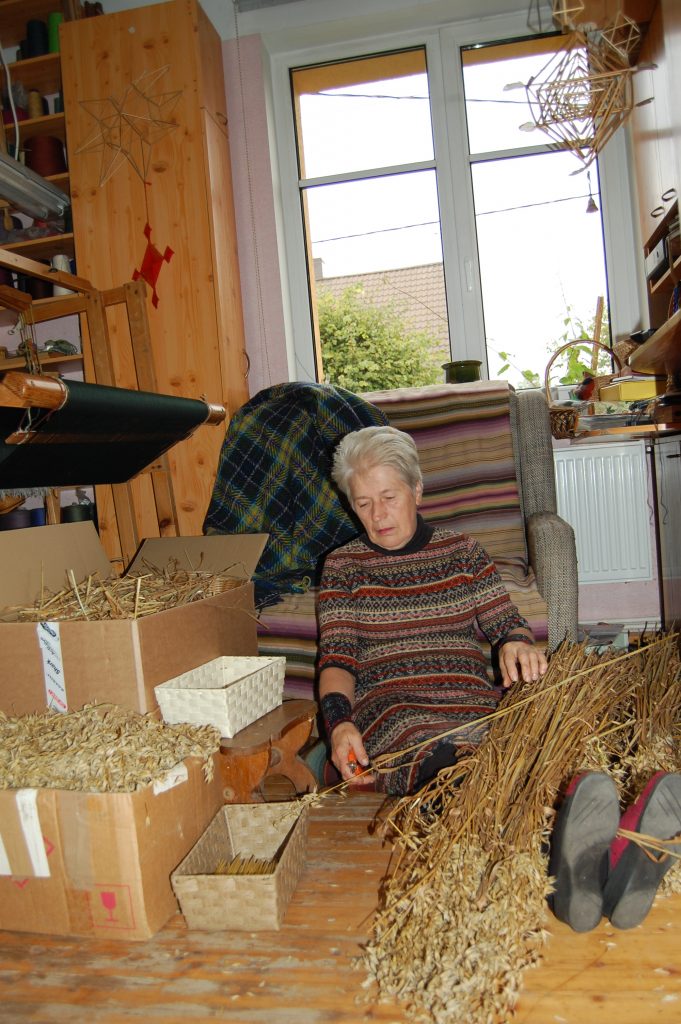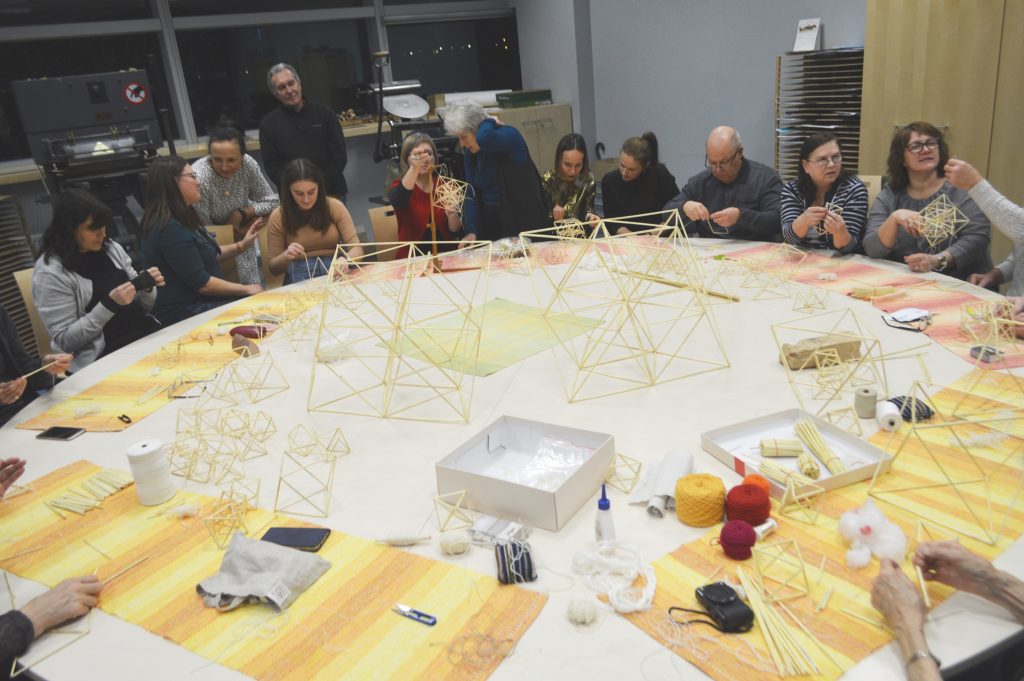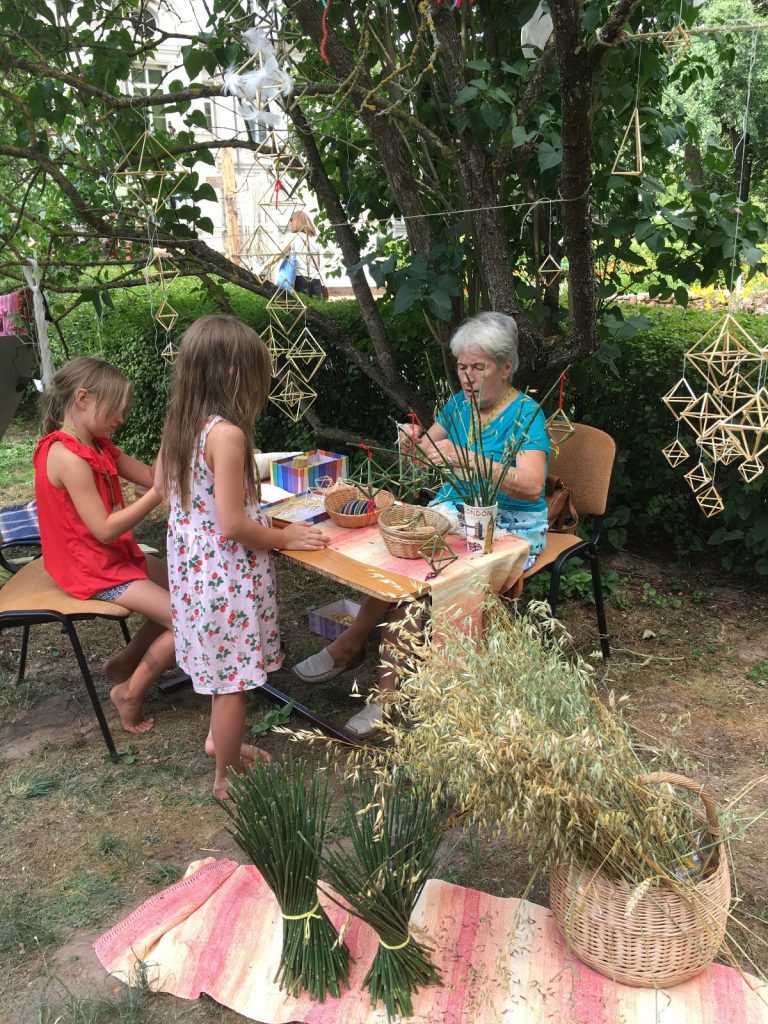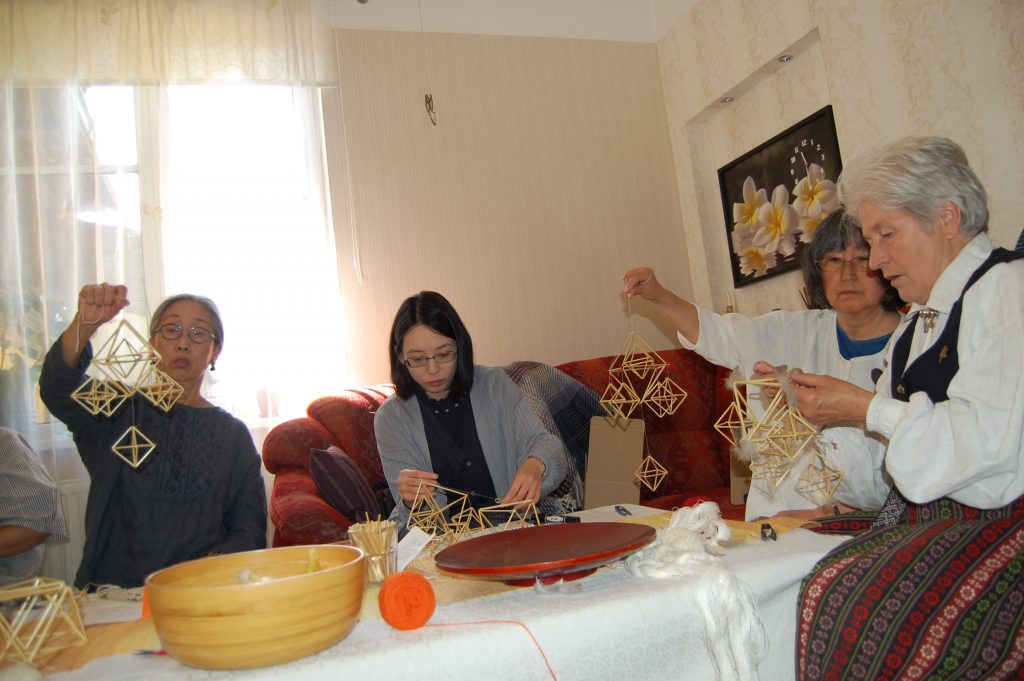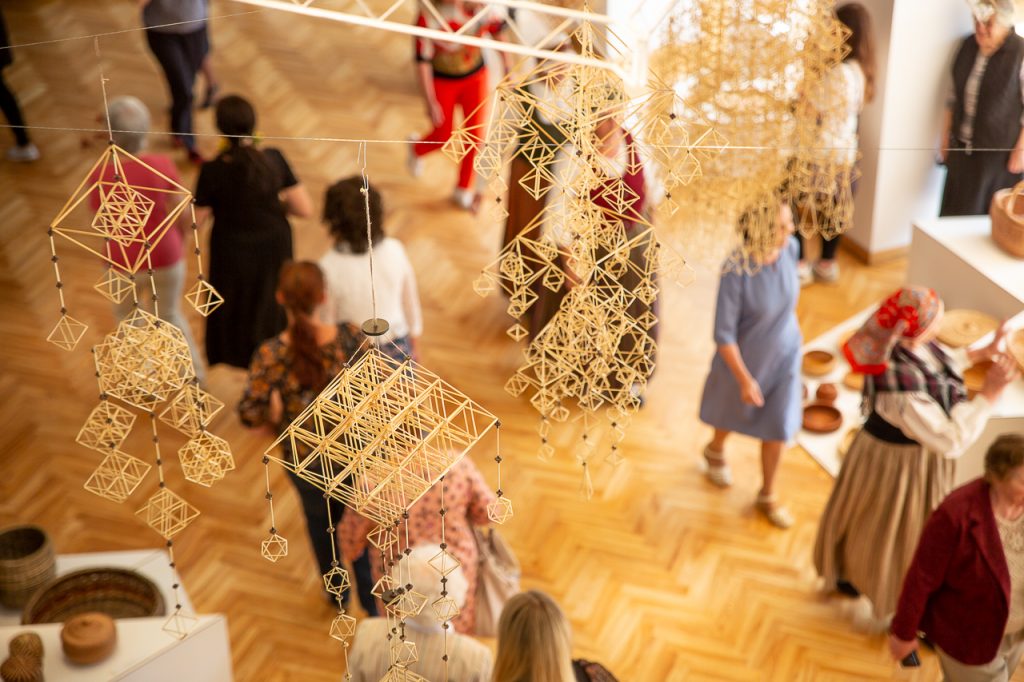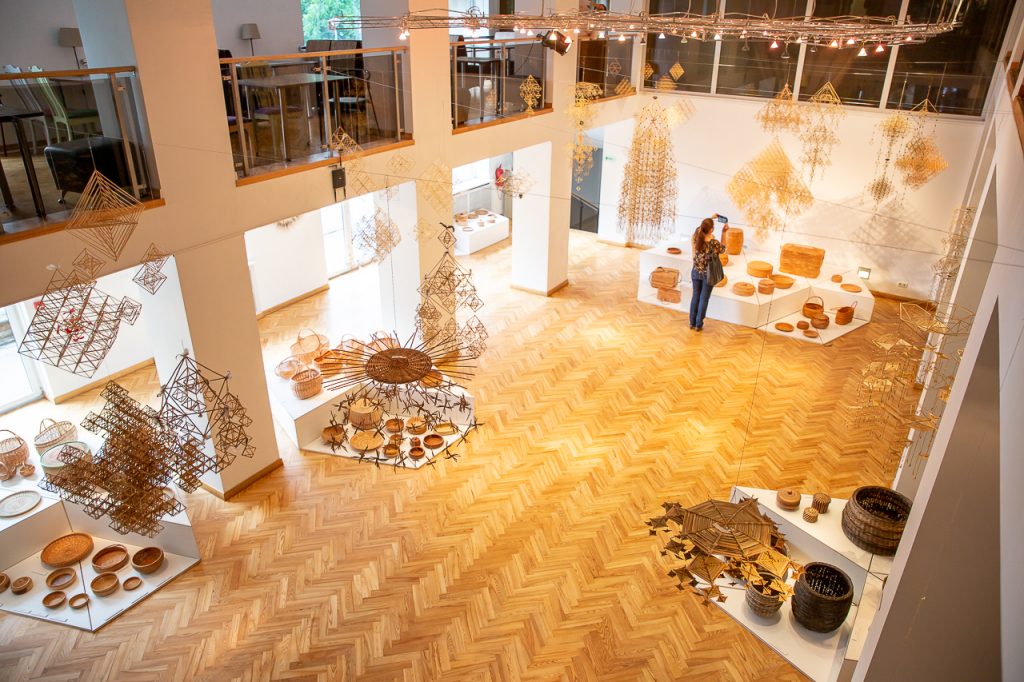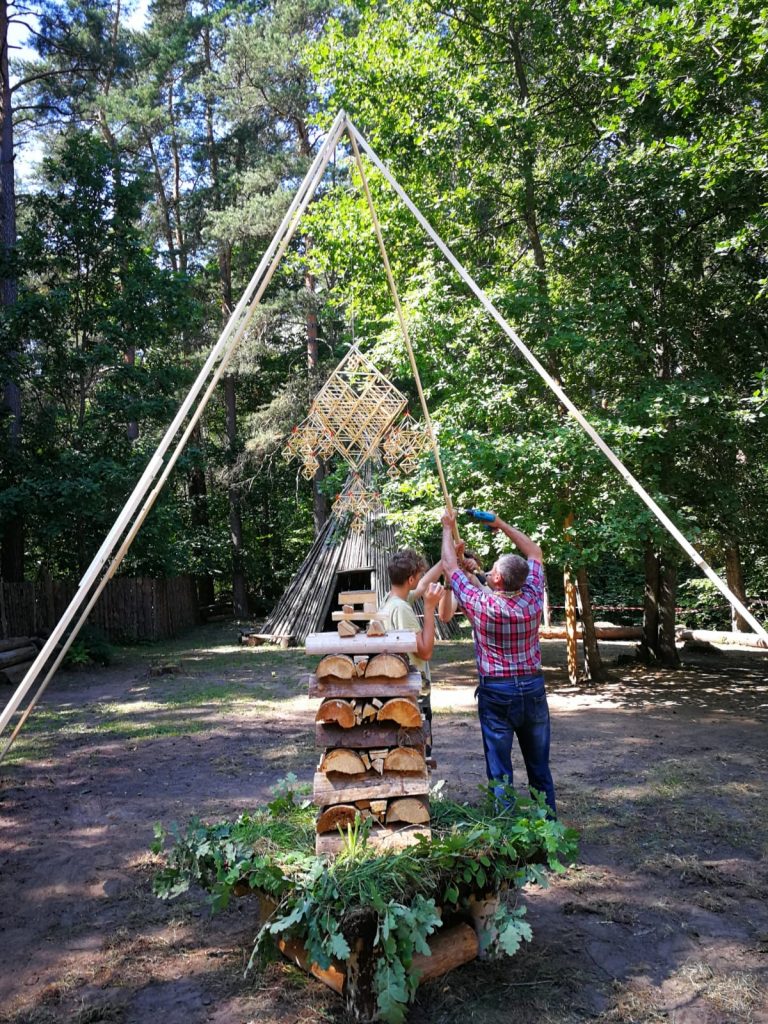Author:
Evelīna Bučele, Jana Bahmane, Lolita Muižniece
Social practices, rituals and festive events
Traditional craft skills
Knowledge and practices concerning nature and the universe
Title
“Puzuri” and the craft of making them in Jelgava (2021)
Puzuri
Also known as: ķisti, kisti, ķisteļi, krīģi, krīži, spurguļi, pūguļi, buzuļi.
Puzuri is the most common name for this decoration. Other terms often refer to different types of “puzuri” with specific design features.
“Puzuri” or “pūzuri” are known across Latvia. A puzurs consists of several conjoined shapes based on a four-, six-, or eight-cornered crystalline shape. Each crystal is formed by threading reeds or straws together. Tassels made of colourful yarn, feathers, wood shavings, and hollow eggs are added.
There is also the simplest puzurs (saulīte, virpulis, buzulis, bumbulis, pūgulis) which is made of a potato, turnip, or other round vegetable. In Vidzeme, they are usually made by inserting straw or stalks of grain into the vegetable; in Kurzeme, slivers of wood were used with clusters of goose feathers.
A lukturis is a type of puzurs made in the shape of a lantern and it reflects the shape of the world as an interconnected crystalline grid. In Latgale, lukturi are made of painted reeds and paper bows. In years when weddings took place, candles were burned in such lukturi.
Ķisti are made of woven straw plates which are suspended from each other horizontally. The first at the top is the largest, while the next is smaller, and they become increasingly smaller and the last one is tiny.
Geography
Jelgava
This is individual work but it is important for all who value this unique cultural heritage to participate in its safeguarding. However, the people primarly involved in making puzuri are the leaders and members of folk art studios and the keepers of traditional Latvian culture.
Puzuri are made by members of the following folk art studios: “Dardedze” (Jelgava), “Rezēda” (Rīga), “Kursa” (Liepāja), “Bauska” (Bauska), “Durbe” (Tukums), “Avots” (Dobele), “Kamene” (Rīga), “Vīkale” (Ventspils).
Artist, designer, and semiotician Valdis Celms has made a significant contribution to the study of puzuri, but master crafter and resident of Jelgava Ausma Spalviņa is the most active and experienced maker in Latvia.
Art school teachers are also involved in teaching puzuri making skills during art class (e.g. at the Talsi Art School).
Importance in Community Life
Today, we understand puzuri mainly as Christmas decorations but in earlier times they were made in the period between fall and spring and on many other festive occasions (weddings, christenings, funerals). This making of this ornament helped endure the dark period of the year; they also served as decoration at a time when there were none. The situation has now changed and there are many options for room decor ranging from colourful plastic balls, strands of lights, and shimmering tinsel. Despite this wide selection, there are still people who prefer to decorate their homes with ornaments they have made themselves of natural materials. As we make puzuri, we organize our own thoughts, make space for imagination because their singular geometric shape can be interpreted and understood in different ways.
Each person has their own views and their own reason for making a puzurs. There are so many different variations because each generation discovers this ancient art anew and interprets it from their perspective adding signs of their times and their own worldview. Some make vivid, complex puzuri but simple puzuri can even be made by children.
Ausma Spalviņa emphasizes that the making of a puzuri involves not only craft skills but also knowledge of geometry and customs related to nature and space (e.g. how to collect and prepare materials). The making process develops character traits such as patience, precision, and imagination. In children, this develops fine motor skills, attention span, and mathematics. While making can serve to sharpen the mind and be a form of meditation, the outcome can be surprising.
Activities
Traditional puzuri can be made of reeds, or rye, oat, or barley straws but the process is the same regardless of the material. The hardest and most labour intensive part of the process is the acquisition and collection of the materials which begins at the end of summer and the beginning of fall. Stalks of cereal grains are most suitable and they are cut as low to the ground as possible to maximize the amount of material obtainable. Threshed grains don’t work because the straws are broken. The straw is tied into bunches and dried. If they are cut right away, the ends dry unevenly. Any leaves are stripped away. Some makers cut up dry straws while others soak them in water. If a particularly shiny puzurs is desired, they can be soaked overnight and up to 24 hours in a citric acid solution (one teaspoon per 10 litres of water). The straws are removed and arranged by size—twelve straws are needed of each size. When damp straws are cut, their ends don’t crack. The cut sections are quickly dried and then the puzurs is made. To make a puzurs a long needle, colourful yarn, dried flowers, feathers, and other decorations are needed. The straws are threaded to form either a square or a triangle. More are then added to form the desired shape. Decorations consisting of grass bows, dried flowers, or other material can be added to the corners. The finished object is hung from a long thread to give it space to turn.
Beliefs, Rituals, Unwritten Rules
There are a number of ancient beliefs about puzuri that have been collected and are held in archives, but there are also some that are still alive and shared among people who make puzuri. If a puzurs is hung above a child’s bed, that child will have good fortune and happiness and be protected from illness and evil. Movement is important because that is the most vivid expression of time. Without movement, things come to a standstill or wither away and time stops. Latvians believe it is a good sign if a puzurs spins, but if it doesn’t, illness or misfortune can be expected. During festivities, puzuri protects the home from evil spirits and witches. They are burned afterward, so that evil spirits can’t take up residence within.
Inheritance and transmission
The work of fine arts studio members and masters can be see in exhibitions; masterclasses and workshops are also available. Masterclasses take place across Latvia at multiple locations including: LMA Latgale campus in Rēzekne, the Latvian National Library, the Rīga Latvian Society, Dobele Craft House, “Latvietes pūrs” Craft House, cultural centres in Jelgava, Mārupe, Jaunpils, Jaunpiebalga, Tukums, Daugmale, Ķekava, Ogre, Iecava, Carnikava), Valmiera Museum, renovation centre “Koka Rīga” [Wooden Rīga], LCA Theatre House “Zirgu pasts,” national costume centre “Senā Klēts,” Vērmanes Garden during the Baltic Festival, the Abgunste Estate, Talsi Art School.
History
Puzuri represent a variety of wonderful shapes made of reeds or rye or wheat straws, egg shells, goose feathers, wood shaving made in Latvia, as well as northern and central Europe. They are ancient, founded in pre-Christian cultural traditions, and one of the oldest types of winter solstice decoration that preceded the Christmas tree in our traditions on Latvian farmsteads. It still isn’t clear, though, where this shape that resembles Egyptian pyramids originated. Some are of the opinion that the basic crystal or octagonal shape originated with our ancestors as as a representation of the structure of the universe. It is possible that the upper surface was the sky, the roof for the world building, while the middle section represented the horizon between the sky and the underworld, the space where our lives on earth take place. The lower surface is the underworld and the realm of dead souls. Whatever the interpretation, in Latvia puzuri were ever present during the winter solstice and at the end of the year, and occasionally, as an element at wedding celebrations. Puzuri can consist of hundreds or even thousands of straws. One of its traditional shapes is the octahedron composed of twelve straws threaded together.
As an item of decor, puzuri were a source of pride, and evidence of diligence and creativity. At Christmas time, the puzurs symbolized joy about the imminent return of light and the sun. They were hung both in corners and the middle of rooms, so that they collect bad energy and energetically purify the space. Puzuri helped endure the dark time of the year, but at Easter or summer solstice they were burned to neutralize the bad energy. They were made anew every year and for a variety of special occasions, including weddings, christenings, and funerals.
From today’s perspective, it is easiest for us to understand its aesthetic aspect as they function as part of interior decoration. Their composition has become increasingly complex and colourful. Today, people choose various non-traditional materials such as metal, glass, and plastic straws.
These skills have persisted and this traditions has endured thanks to folk art studios; however, in earlier times, these skills were passed on within families from generation to generation. Puzuri have been made during all historical periods – even during the Soviet years when Christmas was not an official holiday. There was a rebirth in their making with the Awakening period when there was a desire to return to our roots and our Latvian identity. Ausma Spalviņa’s experience is evidence that puzuri were made during the Soviet period because she learned to make them in the 1950s at the Vecate primary school from her teacher Timma who taught students how to make them. She turned to seriously making puzuri in the 1990s when community interest increased after the national awakening.
Additional Information
People also acquire other knowledge and skills when making puzuri; for example, to observe and become familiar with nature (when collecting and preparing materials), precision and calculation (measuring length and spatial perception), imagination, creativity.
Masters
– Ausma Spalviņa – master of applied folk art, master of puzuri making (Jelgava).
– Brigita Ektermane – artist, healer, author of the book “The Power of Latvian Signs” (Rīga).
– Indra Petraškevica – author of the book “Puzuri”, master of puzuri making.
– Māra Kuplā – information specialist at the Latvian Open-Air Ethnographic Museum (Rīga).
– Maira Freimane – Talsi Art School director (Talsi).
– Makers include: Gunta Celma (Rīga),Andris un Inese Rozes (Āraiši), Aina Strode (Rēzekne), Diāna Apele (Rēzekne), Aigars Šķirmanis (Rēzekne), Dagnija Kupča (Cēsis), Inita Dzalbe (Ventspils), Ilze Vekšina (Smārde), Inta Brikmane (Limbaži), Dagnija Pārupe (Rīga), Lilija Treimane (Rīga), Genovefa Koževņikova (Ozolnieki), Ieva Hofmane (Jelgava), Daina Ieviņa (Dobele), Inta Jansone (Dobele), Antra Kārkla (Dobele), Edmunds Barkāns (Jelgava), Santa Rubene (Jelgava), Valdis Piņķis (Rīga), Indra Kadaka (Rīga), Dagnija Jākobsone (Jelgava), Ārija Bērze (Sigulda), Ineta Vēvere (Garciems), Anita un Andris Žukovski (Jelgava), Vija Liepa (Rīga), Zanda un Uldis Žentiņi (Valmiera), Aija Prince (Dobele), Vita Ozerinska (Burtnieki), Ieva Ančevska (Liepāja), Druvis Cirītis (Jelgava), Vineta Šulca (Tukums), Marita Dubiniauska (Tukums), Ruta Kalniņa (Tukums), Ieva Nahodkina (Tukums), Zane Neilande (Tukums), Rita Meiļūna (Tukums), Anete Spalviņa (Jelgava), Sanita Lipšāne (Jelgava), Inta Grīnofa (Jelgava), Elīna Riekstiņa (Skulte), Iveta un Vidvuds Medeņi (Rīga), Aina un Gvido Tobji (Vidriži), Līga Reitere (Ventspils), Aija Mālkalne (Jelgava), Madara Briede (Rīga), Aija Brikmane (Rīga).
Institutions and Organizations
– Latvian folk art studios.
– Latvian National Centre for Culture.
– Latvian Ethnographic Open-Air Museum.
– Jelgava Municipality Institution “Culture”.
Strengthening the Tradition
The skill of making puzuri as intangible cultural heritage has followed two main directions.
1. Promotion:
1.1. Under the direction of Master crafter Ausma Spalviņa the largest puzurs in Latvia was made in 2016 in collaboration with Swedbank. It weighed 7 kilograms and contained 1,800 crystals consisting of 21,600 straws;
1.2. The Swedbank megapuzurs was a gift to the Jelgava Spīdola High School in 2019. Part of it was displayed in the school, but most of the valuable materials ended up in the shop class where students can learn puzurs threading skills.
1.3. Puzuri made by Ausma Spalviņa were on displayed at an international Christmas tradition exhibition in Atlanta, Georgia (U.S.A.) in late 2020.
1.4. The exhibition “Holiday decorations – the puzuri” at the Limbažu Museum in December 2020.
1.5 An exhibition of large scale puzuri “Puzurs – a model of the world and a symbol of the universe” at the Turaida Museum Reserve in December 2020.
2. Transmission:
2.1. In collaboration with Swedbank video material “The best trick for making a puzurs.”
2.2. Regular participation by Ausma Spalviņa in a variety of master workshops across Latvia.
2.3. Puzuri workshop at the Friends Room at the Latvian National Library in December 2019.
2.4. Introductory event at the International Puzuri and Straw Art Festival, the puzuri making seminar “Zīmes un skaņa” [Signs and Sound] and the exhibition “Basket weaving and puzuri” at the Jelgava Culture House in the summer of 2020.
The “Pinumi un puzuri” [Basket weaving and puzuri] Exhibition was at the Culture House for almost half a year attracted approximately 3,000 visitors of different generations. This project was proof that applied folk art when skillfully presented can be contemporary and compelling to people today. The organizers received many positive reviews about the wide-ranging and multi-facetted exposition. The workshop were attended by people from all three Baltic state including craft masters, as well as others not connected to the folk arts in their everyday lives. There was great interest in both events. Like other previous events, this also showed that the puzuri making tradition continues to be of interest and can successful be integrated into contemporary living and work spaces.
The promotion of the safeguarding and development of the puzuri making tradition has until been subject to successful collaboration between the Jelgave Municipality Institution “Culture” and the Latvian National Centre of Culture.The project the Puzuri Seminar “Zīmes un skaņa” [Signs and sound] were funded by the Latvian National Centre of Culture, the Jelgava Municipality Institution “Culture,” and the Zemgale Culture Programme in the amount of 9,181.52 euros.
While working on the application for the list of Intangible Cultural Heritage, the institution “Culture” had the opportunity to famialarize themselves with the Latvian National History Museum collectons and materials collected by expeditions carried out by the University of Latvia’s History Institute. The greatest tradition developer and ambassadors are the folk art masters themselves where we would like to highlight Ausma Spalviņa role in extending this ancient skills and tradition across Latvia and beyond its borders.
Continuity/Development
The preparation of the application for the Intangible Cultural Heritage list is one of the most important steps toward its safeguarding and sustainable development. An international puzuri and straw art festival is in the works for Jelgava, which will be the largest event in Latvia dedicated to puzuri making in Latvia. Masters from Latvia, Lithuania, and Estonia will be participating and this will become a platform for collaboration and creativity as well as a place where everyone will be able to study this multi-facetted expression of intangible cultural heritage and its philosophy. The workshops and masterclasses are to be documented in photographs and video and they will be placed in the “Kultūra” website and on social media with the goal of educating people about the puzuri tradition in the Baltic and to offer a digital tool for learning puzuri making skills.
Various masterclasses and seminars on the making of puzuri and other traditional interior decorations are planned in the future with emphasis on the transmission of knowledge and skills, as well as on the contemporary transformation in form. It is important to safeguard the ideology of this tradition but also to find a contemporary interpretation that people today can identify with.
The most important upcoming activities:
1. Puzuri-making masterclass at the “Meet Your Master” event in Jelgava in September 2021, organized by the Latvian National Centre for Culture in collaboration with the Jelgava Municipality Institution “Kultūra”.
2. International Puruzi and Straw Art Festival in Jelgava in 2022 organized by the Latvian National Centre for Culture in collaboration with the Jelgava Municipality Institution “Jelgava”.
3. Video material “How To Make a Puzurs” screening to visitors at the Zemgale Restauration Centre.
4. Puzuri-making workshop as part of the “Calendrical Customs” event series in Jelgava, Vecpilsētas Street 2, at tAhe Traditional knowledge and Tradecraft school in the second half of 2022.
The goals of these activities and initiatives is to promote the sustainability of the puzuri making tradition, its safeguarding and developing, and it adaptation to current formats without losing its authentic messaging.
Threats to the Tradition
Today, puzuri skills are mainly being maintained by several institutions and folk arts studio initiatives and their financial support. It would be, though, necessary to have a unified strategy for the development and protection of this element. If regularly scheduled masterclasses, workshops, exhibitions were puzuri can be viewed don’t take place, then there would be threats to the further transmision of this tradition. It is important to pass on not only the craft skills but also the deeper understanding about their symbolic meaning. If this is not done, then the puzurs will become only a decoration without any deeper meaning. That is why the masters and makers have a large role in conveyng interesting information at various seminars, workshops, thematic events. As generations change, the ability to pass these traditions on to the next generation becomes threatened because the world has become more dynamic, lifestyles have changed. Families get together less frequently and do things together (including traditional craft skills). The family is the site where values develop that further develop belonging to traditional culture.
Applicant
Jelgava Municipality Institution “Culture”, registration number 90001282471
Photo Gallery
Video Materials
Text Materials
Publications
Petraškevica, I., Petraškevics, N. (1993). Puzuri. Rīga: Jāņa sēta.
Celms, V. (2007). Latvju raksts un zīmes. Rīga: Folkloras informācijas centrs.
Ektermane, B. (2018). Latviešu zīmju spēks. Rīga: Latvijas Mediji.
Websites
Talsi television material "Traditional Latvian dream catcher - puzurs". - the meaning of puzuri, puzuri types. Instructions on how to prepare materials and make puzurs.
The Central Danube television video “Turku parish people do traditional Christmas decorations – puzurus”. - type of puzuri, meaning. Puzuri making and decoration.
Swedbank Latvia video “The craftmanship of making a puzurs". - an instruction of making a puzurs.

